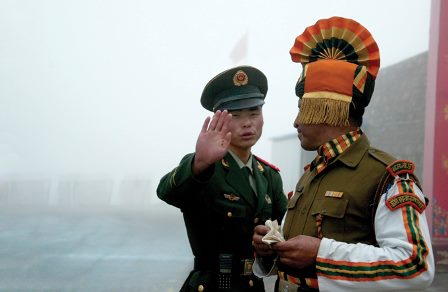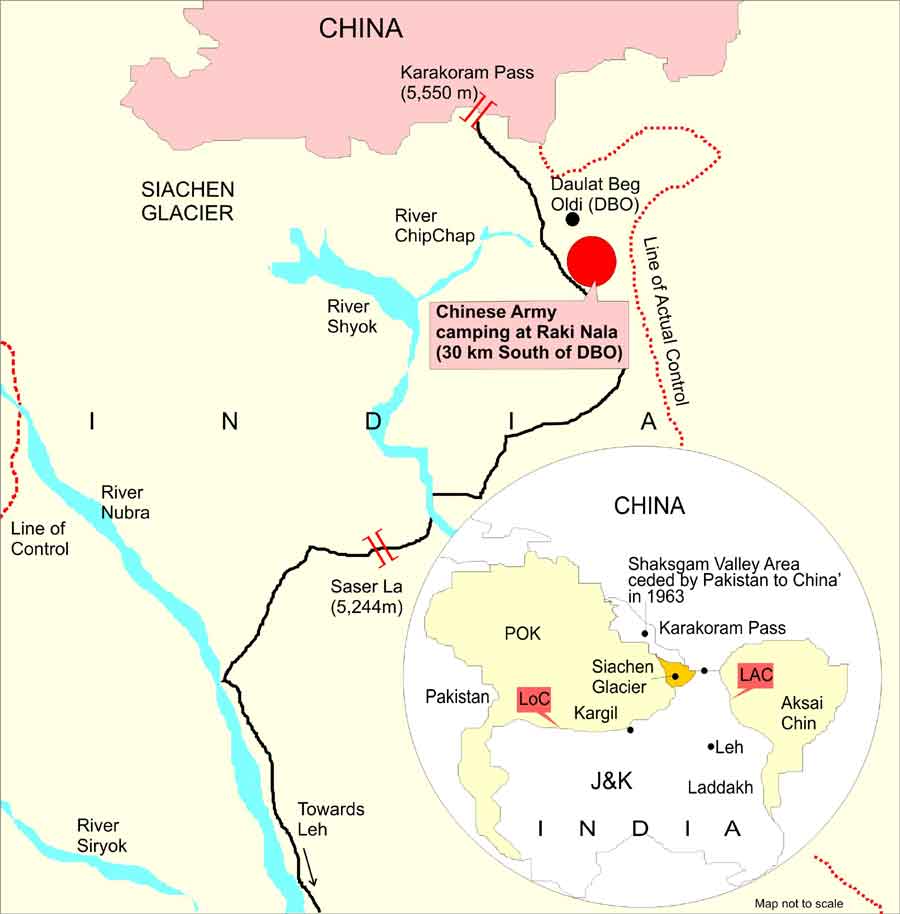Robert Kaplan in his book “The Revenge of Geography” suggests that, “India’s rivalry with China is not like the one with Pakistan: it is more abstract, less emotional, and (far more significantly) less volatile. It is a rivalry with no history behind it.” Therefore, at the highest levels we need to assess more accurately what China’s National Interests are and how and why it regards India as an impediment in its development process. Just as China expects other nations to respect its core interests and sensitivities, so should India make clear its concerns whether it pertains to refuge accorded to the Tibetan Government in exile, or India’s relations with US and/or Japan. India should convey its position emphatically on issues regarding its sensitivity to China’s military and naval presence in the countries around India, China’s relations with Pakistan pivoting on collusive military support aimed to constrain India, or India’s concern with regard to the easy availability of “Made in China” weapons and munitions to insurgents in the North-East and at the same time, India should assertively pursue its own National Interests.
A major weakness with India lies in the lack of knowledge in communication skills in Chinese language.
The recent Chinese incursion across the Line of Actual Control (LAC) in Eastern Ladakh is not a one off incident; neither is it going to be the last of its kind. Therefore, the incident warrants a deeper understanding on this matter of the differing perceptions of the LAC. Notwithstanding the fact that respective perceptions have not been shared or exchanged by both sides, measures to assert India’s claims need to be built-in without an overt display of belligerence. The perceived maladies in the present dispensation and possible recourse are discussed in the succeeding paragraphs.
At the outset it is relevant to note that China has accorded due cognizance to the Chinese armed forces as a prominent element of national power. The Chinese White Paper on Defence released on April 16, 2013, in which China has symbiotically defined the role of the armed forces as, “It is the strategic task of China’s modernisation drive as well as a strong guarantee for China’s peaceful development to build a strong national defence and powerful armed forces which are commensurate with China’s international standing and meet the needs of its security and development interests.”
Further, in pursuit of the doctrine of fighting and winning local wars under conditions of informationalisation, the modernisation of its armed forces is being suitably tailored. At the People’s Liberation Army (PLA) Headquarters, a new Department of Strategic Planning has been established as also the Department of Communications has been reorganised as Department of Informationalisation. Significantly, the Paper further states, “We will not attack unless we are attacked; but we will surely counter-attack if attacked.” These two seemingly innocuous points indicate the desire to be prepared to dominate any situation arising along its borders. Ironically, the 1962 Chinese offensive into India was deemed by them as a “self-defence counter-attack”. That the most recent White Paper on Defence reiterates the latter point should not be dismissed without due consideration.
The Boundary and Territorial Integrity
There are three steps in establishing a country’s boundary – Delimitation, Demarcation, and Delineation. In the 1960 Boundary Talks, both India and China had defined their claimed International Boundary and in the process delimited their respective boundaries. Though the term LAC figured for the first time in the letter to Nehru from Zhou Enlai in November 1959, there was no formal exchange or discussion on the alignment of the LAC during these talks. A dramatic new reality was presented after 1962 with the emergence of an unclear and unresolved LAC. Be that as it may, it behooves the Government of the day to put in place all measures to ensure the sanctity of all its claimed territorial assets with full vigour. To make excuses for any loss of territory by saying that, “not a blade of grass grows there” is indicative of a lack of conviction of its own stance and the perceptible lack of iron will and resolve to back its own consciously considered decisions and statements.
China will look at its boundaries as a consolidated whole, making no distinctions between the maritime and land boundaries.
As a matter of fact, India had always quoted the length of India-China boundary as being 4,056 km. It was reviewed for no apparent reason and pegged at a professed more ‘accurate’ and ‘correct’ length of 3,380 km. In one ill-considered impetuous stroke, India indicated to China that it was not sure of the length of its northern boundary indirectly implying that it probably does not have adequate documentary evidence to emphatically substantiate its claims. This has allowed China to come up with its own figure of 2,000 km. To ease China’s predicament, there are factions getting into a tizzy desperately trying to explain the logic of these figures on behalf of the Chinese thereby placing India on the defensive.
In pursuing its foreign policy, China has categorically declared its sensitivities and core interests. It, unabashedly, expects all countries to respect these. Therefore, it is evident that China will look at its boundaries as a consolidated whole, making no distinctions between the maritime and land boundaries. It should come as no surprise that for any perceived violation by India by its naval vessels of its maritime boundary in the South China Sea, China launches a military quid pro quo operation across the disputed land boundary, manifesting in Eastern Ladakh or Arunachal Pradesh.
There has been much debate on India’s public reaction to the Chinese incursion in Eastern Ladakh to it being dubbed hawkish while the government’s response being dovish. As the situation obtains on the ground, there are military forces and resources positioned in Ladakh to deal with such a tactical contingency. Therefore, it is expected that the Army would have built up adequate forces to take appropriate action to demonstrate its military resolve to restore status quo in this tactical situation that has been presented by the Chinese as also deal with any fallout there from. This is the accepted sequence of tactical actions that are initiated on the Line of Control (LC) with Pakistan by the field commanders in consultation with their immediate superiors. While it is undeniable that diplomacy must be the first instrument of national power to be deployed, to be effective, it must be supported by a robust military contingency plan and forces deployed appropriately in the eventuality the diplomatic talks do not proceed favourably. Without such a back-up military plan through which the nation can demonstrate its will and resolve, the country will be coerced into accepting the opponent’s demand with all its concomitant strategic fallout in its wake. This obviously cannot happen overnight, but should have been consciously developed as a security policy over the long-term. Infrastructure development in the remote areas of our country is a fundamental requirement for such a credible policy.
Every time there is a stand-off of this nature the plethora of debates and discussions that emanate are generally centered round the differing perceptions of the LAC and the resulting pockets of “both-man’s land”, pockets of territory claimed by both over which both forces are patrolling to assert their respective claims. (It is necessary that these pockets are not referred to as ‘no-man’s land’ as that would restrict our own patrolling and surveillance operations launched to dominate these areas). However, any incursion, temporary or as in the recent incident, a more prolonged ‘temporary’ incursion, is a matter restricted to the tactical realm and can be dealt with under the provisions of existing treaties and Confidence Building Measures that are in place.
What is of greater concern is to seek answers as to why China indulges in these power plays and what is its larger game plan? Inevitably such questions will lead to speculations and conjectures of all sorts but that must be accepted. India seems to be surprised by Chinese action each time the PLA makes such a move. It implies that they have skillfully honed their procedures and India is in no position to get advance warning to be in a position to pre-empt the PLA. Ours remains only a knee-jerk reaction confined locally. As a nation, we have not ventured to activate another area at any other point on the LAC, a constraint imposed by the lack of infrastructure. Altering the status quo and risk taking (some will call war-mongering) is anathema. If such capability is not demonstrated in peace-time, it is unlikely during war.
Infrastructure Development
Access to the farthest corners of the frontiers of the country is a strategic imperative for securing its territorial integrity and therefore, is a government’s moral responsibility to its people. A general set of laws and legislations cannot be imposed as a thumb-rule in matters of construction of roads and infrastructure in the frontier areas. This matter was raised as far back as 1998-1999 when ten strategic roads were planned to be constructed, nine in Arunachal Pradesh and one in Eastern Ladakh with funds being allocated annually. Unfortunately, these roads were not exempt from obtaining all the mandatory clearances. As a result even 15 years since the inception only six of these roads are complete while 23 additional roads have been planned and added to the list in the North-East alone. Neither the capacity building of the Border Roads Organisation nor the induction new equipment or technology has kept apace.
There has been much debate on India’s public reaction to the Chinese incursion in Eastern Ladakh to it being dubbed hawkish while the government’s response being dovish.
In our open democratic system, anyone with a misplaced sense of concern for the environment can, through a mere Public Interest Litigation, stall such vital strategic effort, made more abstruse by the paranoia of the Ministries of Forests and Environment. A case in point is the proposal to construct an alternate strategic road in Sikkim – Eastern Sikkim Highway passing through the Panglakha Reserve Forest. Sikkim has one major artery prone to disruption in heavy rains and vulnerable to interception by the enemy in war. This project is being vehemently opposed by various elements. Such projects must be legally protected from these misconstrued delays by the country’s highest court. Another serious and unprecedented revelation came to fore when construction of field defence works were obstructed by the locals in Kameng area of Arunachal Pradesh (AP), claiming their rights over the land as tribal pasture land. That we have come to such a pass where we may be compelled to buy the land on which we have to construct defence emplacements to protect the lives and properties of these very people, is a serious matter.
In a way linked to infrastructure, back in 1998, a case for urgent procurement of speed boats was established for effective operations on the Pangong Tso to enable swift response to incursions by Chinese speed boats on the lake. These fast boats have finally materialised and are now being inducted nearly 15 years after the initial demand was placed. To deny such essential operational resources to troops, who selflessly and unquestioningly carrying out their solemn duty in such far flung remote areas, is truly unfortunate.
Coordinating an Effective Response
India’s patronising attitude towards its neighbours is being exploited by China. It is a moot point to figure out why Nepal and Myanmar which have common boundaries with India and China feel more comfortable with dealing with China than with India. Why do all of India’s neighbours prefer to purchase arms, munitions and equipment from China and not India? In fact, we make such a ceremonial fuss even over handing over a few artillery pieces or bulldozers that it does not go down too well with our few foreign customers.
There is an ill-advised reluctance on the part of Ministry of Home Affairs (MHA) to place the ITBP under the Army.
Robert Kaplan in his book “The Revenge of Geography” suggests that, “India’s rivalry with China is not like the one with Pakistan: it is more abstract, less emotional, and (far more significantly) less volatile. It is a rivalry with no history behind it.” Therefore, at the highest levels we need to assess more accurately what China’s National Interests are and how and why it regards India as an impediment in its development process. Just as China expects other nations to respect its core interests and sensitivities, so should India make clear its concerns whether it pertains to refuge accorded to the Tibetan Government in exile, or India’s relations with US and Japan. India should convey its position emphatically on issues regarding its sensitivity to China’s military and naval presence in the countries around India, China’s relations with Pakistan pivoting on collusive military support aimed to constrain India or India’s concern with regard to the easy availability of “Made in China” weapons and munitions to insurgents in the North-East and at the same time, India should assertively pursue its own National Interests.
As a country we should not succumb to curtailing or modifying our own pursuit of peaceful agendas towards fulfilling the aspirations of the people of India to suit some other country. That would be a classic play out of the Machiavellian hypothesis related to being a neighbour of a powerful country.
War is a national effort with all elements of national power synergized to protect National Interests. Therefore, as a rudimentary measure at the cutting edge, it would translate to ensuring that all forces deployed against a particular country are operating under a single agency so as to synchronise and synergise the collective effort. Ironically, this is not the established norm on ground. While Border Security Forces (BSF) troops deployed along the Line of Control (LC) opposite Pakistan are under the operational control of the Army, it is not so with regard to forces deployed along the LAC. The Army and Indo Tibet Border Police (ITBP) deployed along the LAC operate independent of each other. Except for six joint patrols conducted in Eastern Ladakh under directions of the China Study Group (CSG) in the early 1990s. Consequently, there is gross duplication of effort by the Army and ITBP. In addition, the ITBP unilaterally continues to raise and induct more forces along the LAC. As a result, this time, the Chinese have raised the issue of India’s heightened activities along the LAC.
Our intelligence inputs regarding deployment along the LAC is inadequate to say the least.
Apparently, there is an ill-advised reluctance on the part of Ministry of Home Affairs (MHA) to place the ITBP under the Army. At a macro level, it also indicates a tacit acknowledgment by the Government that the LAC only requires peacetime policing security deployment and is not a “live” border. Since 1986, the Army has been raising the matter for “single point control” of all forces deployed along the LAC for all operations related activities, but the plea is dismissed summarily by the Ministry of Defence (MoD) and the MHA. It would be in National Interest to know the command and control arrangement with regard to the Army and ITBP that is in place in Eastern Ladakh to deal with the current situation. The nature of the coordinated response to the situation presented by the PLA in this recent incursion would also be a matter of interest. The malady does not end there; even the equipment, particularly the radio communication equipment with the two agencies, is not compatible. There should be a central government policy to ensure that equipment purchased by ITBP, BSF and Central Reserve Police Force (CRPF) is mandatorily cleared by the Army for technical and logistics compatibility. National security must be viewed holistically and not parochially to protect or suit certain group interests.
China’s military is only one element of that country’s comprehensive national power. There is an emerging need to have a “China Watch” Cell supported by government agencies to create a comprehensive data-bank on all military, intelligence, diplomatic, economic and boundary aspects related to China. Periodic net-assessment of China’s comprehensive capability should be presented to the country’s highest decision-making body. A major weakness with India lies in the lack of knowledge in communication skills in Chinese language. At most of the Flag and Border Personnel Meetings, the Army has to rely on the Chinese Interpreters. While of late, the Army has streamlined the process to overcome this deficiency, it will take a while to be fully effective. The intelligence gathering apparatus needs to realign its centricity to focus on China with all resources namely, electronics, satellites, Unmanned Aerial Vehicles and HUMINT. Our intelligence inputs regarding deployment along the LAC is inadequate to say the least.
India’s future role in the region is seen by Kaplan as one of being a “regional power due to the reality of its geography that has entrapped it. It can be a potential great power to the degree that it can move beyond it.”
There is also a need to know the identity of Chinese troops who have camped here in general area DBO on our side of the LAC. Whether they are from the local Border Defence unit or from a regular PLA formation, their identity is necessary to formulate further action. Intelligence as to whether this unit moved here for its annual operational area familiarisation or has been inducted for a specific purpose would be essential too. Equally important, intelligence on any complementary build up in the Tibet Autonomous Region (TAR) to support the incursion if matters flare up, will make the situation clearer. Any build-up of PLA Air Force to the airfields in TAR becomes essential to assess the larger picture. Answers to these questions will dictate our stance and further action. The weakness lies herein – the inability to get worthwhile intelligence inputs for taking major strategic decisions when it comes to China.
Over the last two decades, infrastructure development along the border belts has been comprehensively addressed by the Chinese. During a visit of then Chief of General Staff General Fu Quan U in April 1998, he was queried on the increased construction activity in the border region by the PLA to which he replied that the PLA was building three lines namely – road, telephone and electric lines. Those long-term measures are bearing fruit now and are evident from the easy access afforded to the PLA to all the areas claimed by them, particularly in the Western and Middle Sectors. As infrastructure developed, China evolved its strategy of “Trading Space for Time” to the current one wherein pro-active and pre-emptive military operations (to include cyber war and non-contact conventional missile attrition) are built in. China thus visualizes fighting a future war beyond its borders taking it into the adversary’s territory. On the contrary, our political security strategy of restraint will leave us fighting to recover our lost territories. This will also imply that a war, when it comes, may have an unfavourable end for us and at the end of it, will leave us weak at the negotiating table.
India’s future role in the region is seen by Kaplan as one of being a “regional power due to the reality of its geography that has entrapped it. It can be a potential great power to the degree that it can move beyond it.” A “great power” status is not symbolic. It is the result of the synergized deployment of all elements of national power. Internal quibbling for petty local political gains and internecine rivalries will effectively quash all gains made by the dint and dynamism of the vast majority of the people of this country. There is clearly a need to seriously introspect on the path being tread.








Any introspection to be sincere needs some concrete changes at the ground level at the end of that introspection.
Indian “introspections” are more for tamasha rather than any betterment.
First and foremost , India needs to resolve its internal problems with regards to its varied enthnicities and the race-based reservations that were imposed on the country by a landowner mafia in 1989.
Before getting out of the “geographic” trap, India would do well to subdue its own mobs and mafia .
But offcourse that means the use of force-even lethal force- against its own rioting Racist mobs and mafias. Something which India has never done, choosing instead to preach non-violence to others.
The intelligence agencies – non professional, racist, malacious and corrupt that they are (vedic texts speak of RAKSHASAs) – had a hearty laugh and did nothing , instead of preempting the attempt by the landowner mafia (and their bureaucratic minions) of dividing the indian society on racist faultlines by imposing official quotas based on Caste , community ( in Mumbai Gujarati Kelvani mandal, Sindhi Mandal, Khalsa Mandal …. all have quotas for their respective “minority communities” in the colleges affiliated to bombay university).
So India’s problem is not the Geography , neighbours , or anything else. India’s problem is the Racist, intolerant, non professional , anti western(modern) mindset. And the mindset of obfustcating the attention from ground realities by either shouting like dogs, or finger-point(blaming) others…. in the Army’s case , its the politicians to fingerpoint at.
Another tendency which seems to have emerged , at least in the AFSPA states, is to attack Indian citizens through proxies – stone pelters, rioters, “insurgents” et al to make the respective elected governments appear ineffective.
Why blame the chinese incursions??? its no different that the East India company landing in Bengal and finding a Continent collapsing under its weight !!!
Lt. General JS Bajwa has presented an incisive analysis. That the Chines incursion at Depsang Bulge could well have been triggered by Indian Navy’s incursion into Chinese claimed waters is an eye opener.
From the sequence of events, it should now be clear that the incursion was a carefully calibrated show of force. Also the incursion and subsequent withdrawal were pre-planned.
On May 2, three days before the Chinese withdrew, the English edition of the weekly Chinese newspaper The Economic Observer ran an article titled ‘Old Tensions, Big Stakes in China-India Border Dispute’ and summarized it as follows.
The “Tent Confrontation” may well wind up like previous incidents. Having flared up unexpectedly from nowhere, it may also disappear without warning.”
They knew how it would end!
So while the MEA may credit itself for having negotiated a PLA withdrawal without any deal, the truth is the Chinese intended to withdraw, having delivered their message, to ensure that the visit of their Premiere, Li Keqiang, to India was not jeopardized.
In India, the political leadership has little understanding of military matters and so relies heavily on bureaucrats to oversee military affairs. Instead of strengthening democracy in the country to preclude military interference in government, our politicians have chosen to keep the military leadership week and largely subservient.
Dealing with military matters requires knowledge and intelligence, which the bureaucrats have. It also requires a mindset…a certain aggressiveness…a willingness to take risks, all of which the bureaucrats lack. As a result, Indian civilian leadership has a funk induced tolerance threshold that gets more pliant, more accommodating, with increase in provocation.
The leadership sees logic in ceding a few scores of square kilometers of wasteland to China, rather than going to war.
Going to war with what??
We produce nothing. Merit has been given the go by even in the top levels of the Army. We would get our backsides kicked.
We would be terribly hit financially . We would then have to incurr even stiffer financial for future defence purchases than the Gorshkov deal